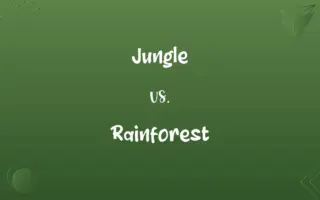Pangolins vs. Anteaters: Know the Difference

By Shumaila Saeed || Updated on December 25, 2023
Pangolins are scaled mammals known for their unique keratin scales, while anteaters are characterized by their long snouts and absence of teeth, both specializing in eating ants and termites.

Key Differences
Pangolins are unique among mammals for their protective keratin scales covering their bodies. They can curl into a ball when threatened. Anteaters, on the other hand, are identified by their elongated snouts and bushy tails, with a dense fur coat but no scales. Their distinct physical traits reflect their different evolutionary paths.
Shumaila Saeed
Dec 14, 2023
Pangolins are primarily found in Asia and Africa, inhabiting tropical forests, grasslands, and savannas. They are known for their burrowing and climbing abilities. Anteaters, in contrast, are native to Central and South America, adapting to a variety of environments including rainforests and grasslands. Their habitats reflect their adaptation to different ecological niches.
Shumaila Saeed
Dec 14, 2023
Both pangolins and anteaters share a diet primarily consisting of ants and termites. However, pangolins use their long, sticky tongues to extract insects from deep crevices and have strong, clawed feet for digging. Anteaters also use their long tongues and snouts for feeding but rely more on their sense of smell to locate food, with less emphasis on digging.
Shumaila Saeed
Dec 14, 2023
Pangolins have a slower reproduction rate, typically giving birth to one offspring at a time. Their lifespan in the wild can vary but generally ranges from 10 to 20 years. Anteaters, particularly the Giant Anteater, can also have a solitary offspring, with a similar lifespan to pangolins. Both species' reproductive strategies are influenced by their solitary and somewhat nomadic lifestyles.
Shumaila Saeed
Dec 14, 2023
Many pangolin species are threatened or endangered, primarily due to illegal wildlife trade and habitat loss. Their unique scales make them a target for poaching. Anteaters face threats from habitat destruction and human encroachment, but they are not as heavily targeted in wildlife trade as pangolins. Conservation efforts for both are crucial to prevent further decline.
Shumaila Saeed
Dec 14, 2023
ADVERTISEMENT
Comparison Chart
Feeding Method
Long, sticky tongue; strong diggers
Long tongue; relies on smell
Shumaila Saeed
Dec 14, 2023
Conservation Challenges
Highly threatened by poaching
Affected by habitat loss
Shumaila Saeed
Dec 14, 2023
ADVERTISEMENT
Pangolins and Anteaters Definitions
Pangolins
Scaled mammals known for their protective keratin plates.
Pangolins are often seen curling into a ball for protection.
Shumaila Saeed
Dec 08, 2023
Anteaters
Toothless mammals known for consuming ants and termites.
Anteaters can eat thousands of ants in a single day.
Shumaila Saeed
Dec 08, 2023
Pangolins
Primarily insectivorous, eating ants and termites.
Pangolins use their long tongues to feed on insects.
Shumaila Saeed
Dec 08, 2023
Anteaters
Characterized by long snouts and bushy tails.
The giant anteater's elongated snout is perfectly adapted for feeding.
Shumaila Saeed
Dec 08, 2023
Pangolins
Found in parts of Asia and Africa, in varied habitats.
Pangolins are increasingly rare due to habitat loss in their native regions.
Shumaila Saeed
Dec 08, 2023
ADVERTISEMENT
Anteaters
Possess a keen sense of smell to locate food.
An anteater can detect an ant colony using its highly developed olfactory senses.
Shumaila Saeed
Dec 08, 2023
Pangolins
Can roll into a ball as a defensive mechanism.
When threatened, pangolins roll up to shield their vulnerable parts.
Shumaila Saeed
Dec 08, 2023
Anteaters
Typically solitary, with unique reproductive habits.
Mother anteaters carry their single offspring on their backs for safety.
Shumaila Saeed
Dec 08, 2023
Pangolins
Among the most trafficked mammals for their scales.
Conservationists are working hard to protect pangolins from illegal trade.
Shumaila Saeed
Dec 08, 2023
Anteaters
Native to Central and South America.
Anteaters are a common sight in the rainforests of South America.
Shumaila Saeed
Dec 08, 2023
Pangolins
Any of several long-tailed, scale-covered mammals of the order Pholidota of tropical Africa and Asia, having a long snout and a sticky tongue for catching and eating ants and termites. Also called scaly anteater.
Shumaila Saeed
Dec 08, 2023
Anteaters
Any of several Central and South American mammals of the suborder Vermilingua that lack teeth and feed on ants and termites, especially the giant anteater.
Shumaila Saeed
Dec 08, 2023
Anteaters
Any of several other animals, including the echidna, aardvark, and pangolin, that feed on ants.
Shumaila Saeed
Dec 08, 2023
Repeatedly Asked Queries
What are anteaters?
Toothless mammals that primarily eat ants and termites.
Shumaila Saeed
Dec 14, 2023
What is the main threat to pangolins?
Illegal wildlife trade and habitat destruction.
Shumaila Saeed
Dec 14, 2023
Where are pangolins commonly found?
In Asia and Africa, across various habitats.
Shumaila Saeed
Dec 14, 2023
How do pangolins protect themselves?
They roll into a ball, using scales as a shield.
Shumaila Saeed
Dec 14, 2023
Are anteaters endangered?
Some species face threats, mainly due to habitat loss.
Shumaila Saeed
Dec 14, 2023
What's unique about a pangolin's diet?
They exclusively eat ants and termites.
Shumaila Saeed
Dec 14, 2023
What's the gestation period for a pangolin?
It varies, but generally around 70 to 140 days.
Shumaila Saeed
Dec 14, 2023
What's the lifespan of an anteater?
About 10 to 20 years, depending on the species.
Shumaila Saeed
Dec 14, 2023
Do pangolins have good eyesight?
Their eyesight is poor; they rely more on smell and hearing.
Shumaila Saeed
Dec 14, 2023
What's the biggest threat to anteaters?
Habitat destruction and human encroachment.
Shumaila Saeed
Dec 14, 2023
Are anteaters active during the day or night?
Most species are nocturnal or crepuscular (active at twilight).
Shumaila Saeed
Dec 14, 2023
Share this page
Link for your blog / website
HTML
Link to share via messenger
About Author
Written by
Shumaila SaeedShumaila Saeed, an expert content creator with 6 years of experience, specializes in distilling complex topics into easily digestible comparisons, shining a light on the nuances that both inform and educate readers with clarity and accuracy.































































